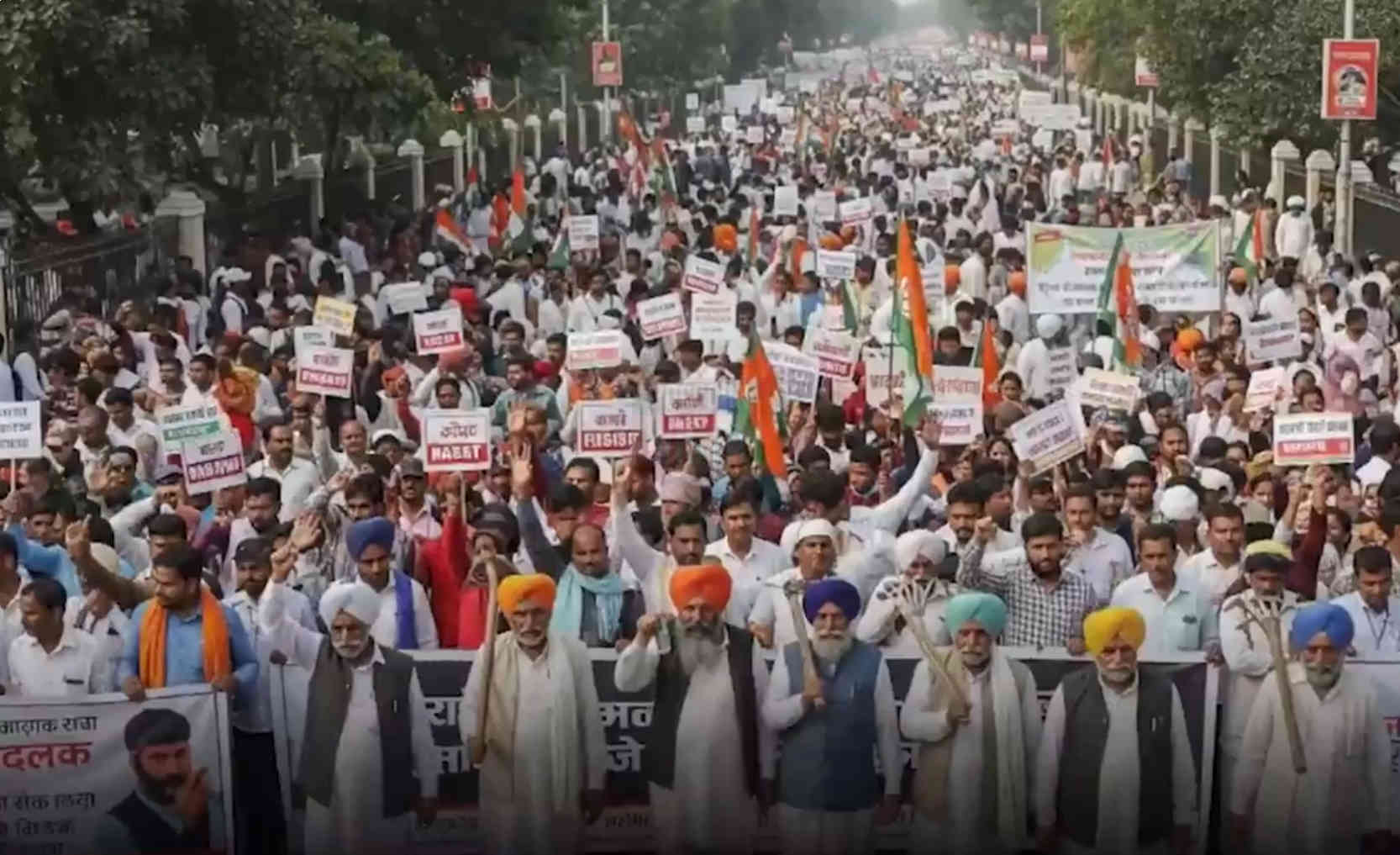On July 9, 2025, millions of people across India stopped work for a huge strike called Bharat Bandh. Over 25 crore (250 million) workers, farmers, and rural workers joined hands to protest against the government’s rules, which they say hurt workers and farmers while helping big companies. Ten major trade unions, like the All India Trade Union Congress (AITUC) and Indian National Trade Union Congress (INTUC), led the strike, with support from farmers’ groups like Samyukta Kisan Morcha. The strike caused big disruptions in places like banks, post offices, and public buses, but schools, private offices, and trains mostly kept running.
Wow, so many people striking together? This is huge! I can’t believe how much India’s standing up today!
Why Are They Striking?
The strikers are upset about four new labour laws passed by India’s Parliament. They say these laws make life harder for workers by:
-
Making it tougher to go on strike.
-
Letting companies increase work hours.
-
Not punishing bosses who break labour rules.
They’re also angry about:
-
Privatization: Selling government-owned companies, like power plants or banks, to private businesses, which could cut jobs.
-
Contract Jobs: More jobs are temporary or “contract-based,” meaning no job security or fair pay.
-
Outsourcing: Companies hiring outside workers instead of giving steady jobs to locals.
The unions want better wages, more jobs for young people, and stronger worker rights. Farmers are joining because they feel government policies hurt them too, like high prices for seeds or low pay for crops. Last year, the unions gave a list of 17 demands to Labour Minister Mansukh Mandaviya, but they say the government ignored them.
These laws sound unfair! I get why workers and farmers are so mad and want change.
Who’s Joining the Strike?
The strike is led by 10 big trade unions:
-
All India Trade Union Congress (AITUC)
-
Indian National Trade Union Congress (INTUC)
-
Centre of Indian Trade Unions (CITU)
-
Hind Mazdoor Sabha (HMS)
-
Self-Employed Women’s Association (SEWA)
-
Labour Progressive Federation (LPF)
-
United Trade Union Congress (UTUC)
-
All India United Trade Union Centre (AIUTUC)
-
Trade Union Coordination Centre (TUCC)
-
All India Central Council of Trade Unions (AICCTU)
Workers from banks, insurance companies, post offices, coal mines, steel factories, and public buses are striking. Farmers from groups like Samyukta Kisan Morcha, who led big protests in 2020-21, are holding rallies in villages. Even workers from government companies like NMDC Ltd (mining) and Railways are showing support, though train workers aren’t fully striking.
So many groups teaming up? That’s like a giant superhero squad fighting for fairness!
What’s Getting Disrupted?
The strike is hitting a lot of services across India:
-
Banks: Many public banks, like State Bank of India, are closed or slow because workers are striking.
-
Post Offices: Mail delivery and post office services are stopped in many places.
-
Public Transport: State-run buses are off the roads in some states, and protests are blocking roads, causing traffic jams.
-
Coal Mines and Factories: Mining and factory work is paused, slowing down production.
-
Power Supply: Over 27 lakh power workers are striking, which might cause power cuts in some areas.
-
Farmer Rallies: Villages are seeing big protests, with farmers blocking roads.
But some things are still working:
-
Schools and colleges are mostly open, though some face transport issues.
-
Private offices and shops are running as usual.
-
Trains are mostly on time, but protests near stations might cause delays.
-
Hospitals, internet, and emergency services are not affected.
Banks and buses stopped, but schools are open? This strike’s shaking things up but not everything!
Where Are the Big Protests?
The strike’s happening all over India, with big action in these places:
-
Bihar: Two protests are happening! One is the Bharat Bandh, and another is a “Bihar Bandh” against changes to voter lists, which protesters say might leave out poor and marginalized people. In Patna, near Danapur Court, protesters blocked roads and burned tyres. In Arrah, MP Sudama Prasad led a highway blockade, and former MLA Arun Yadav marched from a railway station, asking shops to close. CPI(ML) MLA Amarjeet Kushwaha said, “The government’s using the Election Commission to cheat workers and farmers.”
-
Odisha: Protesters stopped trains in Berhampur and blocked roads in cities, with bank and postal workers joining in.
-
West Bengal: Huge protests in Howrah and Kolkata, where strikers stopped trains at Jadavpur Railway Station and marched with slogans against the government. Roads in Kolkata looked empty, and shops stayed shut.
-
Puducherry: A total shutdown! No buses, markets closed, and schools shut down. The INDIA bloc and unions led protests with a 21-point demand list, like better jobs for young people.
-
Punjab: Punjab Roadways, PUNBUS, and PRTC contract workers started a three-day strike (July 9-11). They sat outside the Pathankot depot, demanding better pay and job security.
-
Kerala: Public transport was hit hard, with buses off the roads. Teachers’ groups joined, shutting some schools.
Bihar’s got two bandhs at once? And Puducherry’s totally shut down? This is wild!
What’s the Bihar Voter List Issue?
In Bihar, besides the Bharat Bandh, there’s a separate protest against the Special Intensive Revision (SIR) of voter lists. Opposition parties, like RJD and CPI(ML), say the Election Commission’s changes might remove 20% of voters, especially poor and migrant workers, from voting. RJD leader Premchand Yadav said, “Bihar’s shut down today to fight the Election Commission, which is acting for big powers.” Protesters blocked railways, roads, and bus stands, causing big disruptions. They’re also mad about the same labour laws as the Bharat Bandh, so the two protests are mixing together.
Voter lists messing with people’s right to vote? That’s so unfair! I get why Bihar’s so upset.
Why Are People So Angry?
The unions and farmers say the government’s policies are making life harder:
-
No Jobs: Youth unemployment is high, with 17% of young people jobless, especially those aged 20-25. The government’s hiring retired workers instead of young ones in places like Railways and steel factories.
-
High Prices: Food like pulses and veggies costs 8% more, making it tough for families to afford basics.
-
Low Wages: Many workers’ pay hasn’t gone up, even though things cost more.
-
Less Welfare: The government’s spending less on schools, hospitals, and other public services, hurting poor and middle-class families.
-
No Talks: The government hasn’t held the Indian Labour Conference in 10 years, where workers’ issues are discussed.
The unions also say the government’s new laws, like the four labour codes, help big companies while ignoring workers. They want a minimum wage of Rs. 26,000 a month, more MGNREGA work days, and an old pension scheme back.
No jobs and higher prices? That’s so tough! I see why millions are out protesting today.
Has This Happened Before?
Yes, this isn’t the first big strike! Trade unions and farmers have done Bharat Bandhs before:
-
November 26, 2020: Millions struck against new labour and farm laws.
-
March 28-29, 2022: Another huge strike for similar reasons.
-
February 16, 2024: Workers and farmers protested again, pushing for better policies.
Each time, they’ve asked for fairer laws, but they say the government hasn’t listened. The 2020-21 farmers’ protests, led by Samyukta Kisan Morcha, even got three farm laws canceled, showing how powerful these groups can be.
They’ve been fighting for years! These workers and farmers are super strong for not giving up.
What’s the Government Saying?
The Labour Ministry hasn’t made a big statement about the strike yet. But officials have said privately that the four labour codes are meant to make business easier and create more jobs by simplifying rules. They say the Employment Linked Incentive (ELI) scheme helps companies hire more people. However, unions disagree, saying these rules only help bosses, not workers. The government also says states should handle some labour law issues, but unions argue the central government’s pushing unfair policies.
The government says it’s helping, but the strikers don’t buy it? This fight’s getting intense!
How’s It Affecting Daily Life?
The strike’s causing chaos in some places:
-
Cities: Bengaluru, Mumbai, and Kolkata are seeing protests, roadblocks, and fewer buses. In Kolkata, roads looked deserted, and shops were closed.
-
Villages: Farmers are blocking roads and holding rallies, slowing down rural work.
-
Travel: Public buses and taxis are hard to find in states like Kerala and Punjab. Train delays are possible near protest spots, like Jadavpur in West Bengal.
-
Banks: People might struggle to visit banks or get cash because of striking workers.
But life’s not stopped everywhere. Schools, private offices, and hospitals are open, and trains are mostly running. People are advised to check local news, plan extra travel time, and avoid protest areas.
Some places are super quiet, others are normal? This strike’s a big mix of chaos and calm!
Why This Matters
The Bharat Bandh shows how frustrated India’s workers and farmers are. With 25 crore people striking, it’s one of the biggest protests ever! It’s not just about labour laws—it’s about jobs, fair pay, and a better life for millions. The Bihar voter list issue adds fuel, showing people feel the government’s not listening to them. This strike could push the government to talk with unions and farmers, maybe even change some rules. It’s also a big moment before the 2026 elections, as opposition parties like the INDIA bloc are backing the protests.
This is such a huge deal! India’s workers and farmers are shouting loud for change. What do you think about this giant strike? Tell me!

